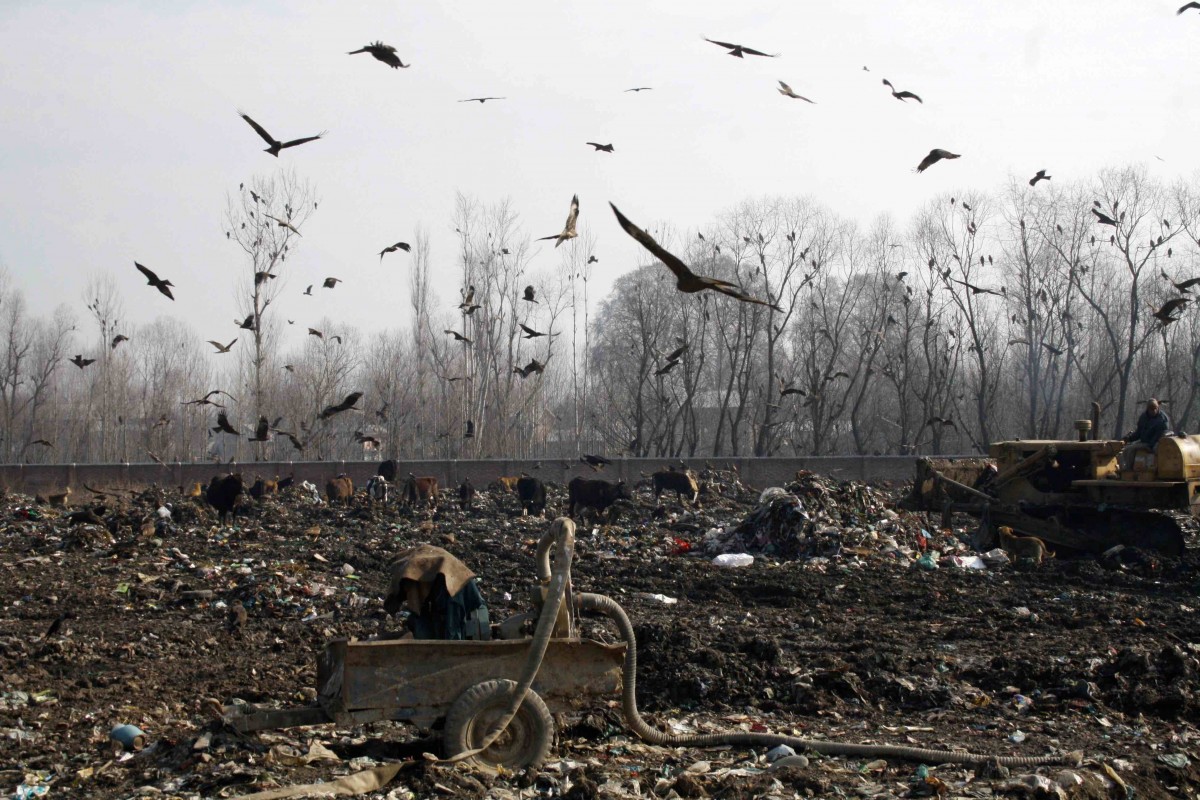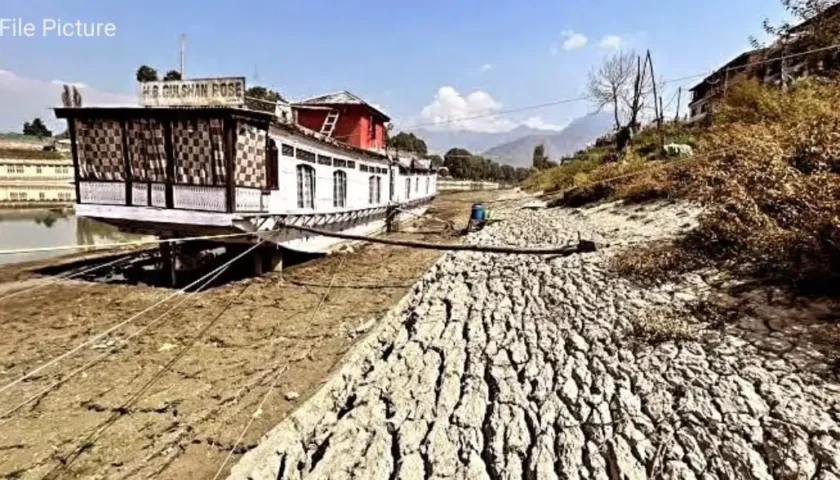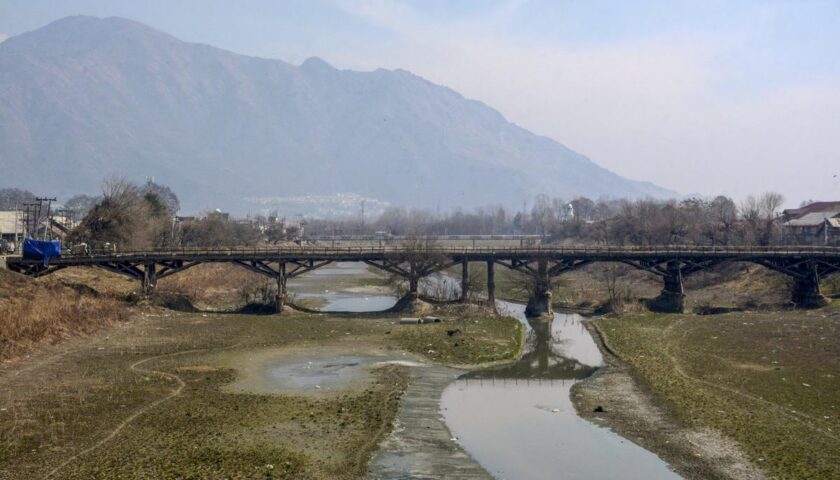Trash Tower: Srinagar’s Ugly Truth and the SMC’s Test
By: Javid Amin | 04 October 2025
The Stench of Neglect
On a damp Friday morning, drizzle fell softly over Srinagar’s Achan landfill, but it brought no comfort.
Instead of freshness, the air was thick with the stench of decay that drifted across neighborhoods — Nowshehra, Lal Bazaar, Soura, and Eidgah.
Children waiting for school buses covered their noses with handkerchiefs. Shopkeepers sprayed cheap room fresheners into the air. Windows were shut tight despite the humidity.
What was once a quiet stretch of land in Syedpora has, since 1985, morphed into a grotesque mountain of garbage — a “Trash Tower” that now stands as Srinagar’s ugliest truth.
More than a landfill, Achan has become a monument to urban apathy — a visible scar on the city’s landscape and conscience.
A 40-Year Pile of Problems
The Achan landfill occupies around 517 kanals (about 65 acres) of land on the city’s outskirts. What began as a modest dumping site for household waste has ballooned into a towering heap of untreated garbage — estimated at over 11.5 lakh metric tonnes of legacy waste.
Over the decades, this site has evolved from a stopgap solution to a permanent environmental hazard.
How It Started
In the mid-1980s, with Srinagar’s population around 6–7 lakh, waste generation stood at just 80–100 tonnes per day. There was little thought given to scientific waste disposal.
But four decades later, with over 1.8 million residents and an additional floating population of tourists, the city now produces over 600 tonnes of waste daily — food scraps, plastics, construction debris, biomedical waste — all ending up in Achan.
No segregation, no scientific processing, no recycling. Only a slow, steady burial of collective negligence.
The Symbol of a Failing Urban Model
The Achan landfill is more than a physical site. It symbolizes the failure of urban planning, civic accountability, and sustainable governance in a city aspiring to be a Smart City.
Srinagar’s inclusion in India’s Smart Cities Mission promised clean energy, waste segregation, and efficient resource use. Instead, its most visible landmark from the air remains a grey-brown garbage mound, visible even on satellite imagery.
Locals now call it the “Trash Tower of Kashmir.”
“It’s not just garbage — it’s government negligence in solid form,” remarks an environmental activist from Lal Bazaar.
Health and Environmental Impact: The Silent Poison
For communities living around Achan, the landfill is a daily assault on health and dignity.
Air and Water Contamination
The leachate (toxic liquid formed when waste decomposes) seeps into the soil and groundwater. The Dal Lake, barely 3 km away, risks contamination from this leachate through connected channels.
Mosquitoes, stray dogs, and rodents thrive here. Residents report an increase in respiratory illnesses, eye infections, and skin diseases, especially among children.
“My kids cough all night when the wind blows from Achan’s side,” says Khalida Begum, a resident of Soura. “The smell never leaves. Even our food tastes of garbage.”
Air Quality Deterioration
The decomposition of waste releases methane, carbon dioxide, and hydrogen sulfide — potent greenhouse gases. On calm days, the air hangs heavy with toxins.
Experts from SKIMS (Sher-i-Kashmir Institute of Medical Sciences) have warned that prolonged exposure may cause chronic respiratory and cardiovascular issues.
The SMC’s Promise: A Turning Point or Another Paper Plan?
After years of public outrage, judicial pressure, and environmental activism, the Srinagar Municipal Corporation (SMC) has finally been forced to act.
Following an order by the National Green Tribunal (NGT), the SMC submitted a four-phased remediation plan aimed at zero-landfill dependency by March 2027.
The Commitment
The plan pledges to clear 11.5 lakh metric tonnes of legacy waste through a structured approach involving bio-mining, waste segregation, and sustainable processing.
NGT’s order includes strict timelines and mandates monthly progress reports, JKPCC (J&K Pollution Control Committee) vigilance, and a public online dashboard for transparency.
Phase-Wise Breakdown of the SMC’s 4-Phase Remediation Plan
Phase 1 (2025–2026): Immediate Action & Odour Control
-
Establish a Leachate Treatment Plant to process toxic liquid runoff.
-
Apply anti-odour chemicals and bio-enzymes to reduce foul smell.
-
Begin levelling and stabilizing waste mounds for treatment.
-
Plant 3,200 trees to create a green buffer zone between the landfill and nearby communities.
Current Status:
Despite commitments, sources confirm that the leachate treatment plant is yet to begin operation. Levelling of waste has started, but odour control remains minimal.
Phase 2 (2026): Bio-Mining & Segregation Expansion
-
Initiate bio-mining — a scientific process that separates recyclable, combustible, and inert waste.
-
Expand composting capacity to 150 tonnes per day.
-
Install advanced segregation units for daily waste from Srinagar households.
This phase is critical to reduce the legacy load while managing new waste efficiently.
Phase 3 (2026–2027): Waste Reduction & Decentralization
-
Clear at least 50% of accumulated waste by end-2026.
-
Establish decentralized waste processing centers across Srinagar’s zones.
-
Bio-mine 5 lakh metric tonnes of legacy waste.
These micro-centers will manage local waste closer to generation points — reducing the daily inflow to Achan.
Phase 4 (2027): Full Site Remediation & Green Conversion
-
Achieve complete legacy waste clearance.
-
Convert reclaimed land into green spaces, parks, and biodiversity zones.
-
Plant an additional 10,000 trees to restore ecological balance.
-
Integrate waste-to-energy units — a 300 TPD Refuse-Derived Fuel (RDF) plant and 459 TPD Compressed Bio-Gas (CBG) unit.
This final phase envisions turning a site of shame into one of sustainability.
Bio-Mining: A Hope for Regeneration
Bio-mining is a tested scientific method that India’s leading cities — Indore, Pune, and Varanasi — have used to eliminate legacy landfills.
It involves excavating old waste, segregating it into:
-
Recyclables: plastics, metals, glass
-
Compostable materials: organic matter turned into fertilizer
-
Inert waste: used for road base or landfill cover
When executed efficiently, bio-mining can recover up to 80% of the land and drastically reduce methane emissions.
Experts estimate that Srinagar could reclaim over 300 kanals of land currently buried under waste — a massive environmental and economic opportunity.
A Green Buffer: More Than Cosmetic
The SMC’s plan to plant 3,200 trees initially and 10,000 more later around Achan is not symbolic.
Trees act as natural filters, absorbing pollutants and shielding nearby homes from odour and particulate matter.
Species like poplar, willow, and pine, native to the Valley, can help stabilize the soil, attract birds, and improve local microclimate.
However, urban ecologists caution that tree plantations cannot substitute proper waste treatment. Without genuine remediation, greenery risks becoming a cosmetic cover for deeper decay.
NGT’s Role: Accountability Through Law
The National Green Tribunal has played a pivotal role in forcing compliance. Its order mandates:
-
Monthly progress reports by SMC
-
Monitoring by J&K Pollution Control Committee
-
Public dashboard for transparency
-
Penalties for delay or falsified reporting
The NGT has also emphasized citizen participation — calling for civil society and media to track progress.
“Achan is not just a municipal issue. It’s a human rights and public health issue,” the Tribunal observed during hearings.
Public Outcry and Citizen Voices
For residents, faith in official promises has worn thin.
Local environmental collectives like “Clean Srinagar Movement” and student-led groups from Kashmir University have staged awareness campaigns, urging SMC to act faster.
“Every Smart City claim sounds hollow when we live next to a mountain of waste,” says Suhail Ahmad, a university student from Zadibal.
Social media too has amplified the crisis. Drone videos of the landfill’s massive expanse have gone viral, sparking online outrage and renewed scrutiny.
Beyond Achan: The Bigger Waste Crisis
Srinagar’s problem doesn’t end at Achan. The city generates 600+ tonnes of daily waste, with nearly 70% being organic, yet segregation at source is below 20%.
Plastic packaging, e-waste, and biomedical refuse often mix with household garbage, creating toxic cocktails that complicate treatment.
The lack of door-to-door segregation, public awareness, and community participation remains a major gap.
“We can’t solve the problem if we keep dumping everything in one bin,” says an SMC official on condition of anonymity.
Learning from Others: Models of Success
Cities like Indore, Surat, and Mysuru have achieved near-zero landfill dependency through a combination of policy, public participation, and technology.
-
Indore: Daily segregation at household level + decentralized composting + efficient waste-to-energy plant.
-
Surat: GIS-based waste tracking and 24-hour response teams.
-
Mysuru: Strong community involvement through NGOs and resident welfare associations.
If Srinagar’s plan aligns with these models — and remains transparent — it could transform from laggard to leader.
Accountability and Transparency: The Real Test
The NGT has already flagged delays in previous commitments, calling out SMC for slow progress.
To regain credibility, the Corporation must:
-
Publish monthly public dashboards of real progress.
-
Involve independent environmental auditors.
-
Partner with research institutions for data transparency.
-
Empower ward-level waste committees to ensure segregation at source.
Local Reflections: Hope, Anger, and Fatigue
In Eidgah, a group of residents gather for Friday prayers amid the lingering odour of decay.
Their frustration is palpable.
“We’ve heard plans before — masterplans, vision documents, and slogans,” says Bashir Ahmad, a retired teacher. “We’ll believe it when the mountain begins to shrink.”
And yet, amid despair, there’s cautious optimism. For the first time in decades, there’s a structured plan with judicial oversight. Whether it succeeds will determine Srinagar’s environmental future.
The Broader Message: Smart Cities Need Smart Sustainability
Srinagar’s waste crisis is a microcosm of India’s urban paradox — expanding skylines and infrastructure without ecological foresight.
The “Smart City” label loses meaning when basic environmental management fails. Real smartness lies in waste reduction, recycling, and citizen engagement.
If the SMC’s 2027 roadmap succeeds, Achan could transform from symbol of shame to a case study in urban renewal. If it fails, it will remain a cautionary tale for generations.
Bottom-Line: From Trash Tower to Green Hope
The Achan landfill has grown for 40 years — layer upon layer of garbage, bureaucracy, and neglect.
It now stands as both a monument of failure and a possibility of redemption.
Srinagar’s future depends on whether the city can turn this mountain of waste into a meadow of renewal — through transparency, technology, and the will to act.
Because in the end, the story of Achan is not just about garbage.
It’s about how a city treats its people, its land, and its promises.




